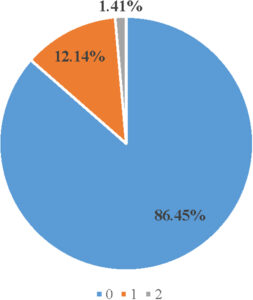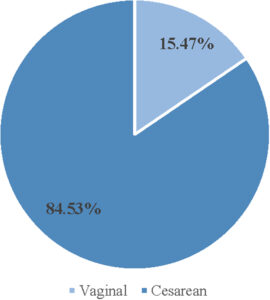Diastasis Recti Abdominis Common During, After Pregnancy

Click to Enlarge: Number of deliveries among ADSW with DRA. ADSW, active duty service women; DRA, diastasis recti abdominis. Source: Womens Health Reports
BETHESDA, MD — Diastasis recti abdominis (DRA) is a common condition in pregnant and postpartum women, occurring when the rectus abdominis muscles, commonly called the six-pack ab muscles, separate from being stretched. That can make the belly bulge for months or years postpartum.
While it might be a cosmetic issue for most new mothers, the implications can be greater for women serving in the military.
Risk factors for DRA include age, sex, multiparity, cesarean delivery, diabetes, gestational weight gain and high birth weight, according to a new study seeking to estimate the prevalence of the condition in the U.S. military.
Researchers from the Uniformed Services University of the Health Sciences and the Henry M. Jackson Foundation for the Advancement of Military Medicine, both in Bethesda, MD, used medical claims data from U.S. active duty servicewomen (ADSW) to determine associated risk factors.
Their cross-sectional study of ADSW in the U.S. Army, Air Force, Navy and Marine Corps was conducted for fiscal years (FYs) 2016 to 2019 and identified military personnel with a diagnosis of DRA during the study period. The study team evaluated factors, including age, race, socioeconomic status, branch of service, military occupation, delivery type and parity. The results were published in Women’s Health Report.1
The review identified 340,748 ADSW from FY 2016 to 2019, with 2,768 (0.81%) having a medical claim for DRA. “Of those with deliveries during the study period, 1.41% were multiparous and 84.53% had a cesarean delivery,” the researchers pointed out. “Increased risk of DRA was found in ages 30 to 39 years, Black women, ranks representing a higher socioeconomic status, and women with overweight and obese body mass indices.”
The authors noted that, while the prevalence of DRA in the study population was low, “subpopulations may be disproportionately affected by the condition. Further research could potentially detail the impact of DRA on the functional impairment and operational readiness of ADSW in the U.S. military, and any possible means of prevention.”
Background information in the article advised that, because of differences in assessment methods, the prevalence of DRA ranges vary widely from 27% to 100% during pregnancy and 30% to 68% in the postpartum period. “Additionally, DRA is likely underdiagnosed, as documented by healthcare providers, due to low patient reporting or lack of provider awareness or understanding of the condition. As a result, most published studies on DRA have small sample sizes,” the researchers added.
They further pointed out the lack of a consensus on the risk factors for developing DRA, adding that “proposed and researched factors include older age, sex, multiparity, cesarean delivery, diabetes, gestational weight gain, and high birth weight Furthermore, one study reported an increased likelihood of DRA among women exposed to frequent heavy weight lifting.”
The authors also emphasized that diastasis recti is not just a cosmetic concern, because the condition can contribute to reduced trunk stability, low back or lumbo-pelvic pain, abdominal pain or weakness, and urinary incontinence. “Treatment options for DRA include both surgical and nonsurgical methods, but there is a lack of clear clinical practice guidelines for best practices for either method. Despite the lack of established best practices, treatment often begins with physical therapy and may escalate to surgical repair if insufficient improvement is made,” the study stated.
Those complications can be especially difficult in the MHS, which serves more than 1 million active duty service women, including women at risk for DRA. The study pointed out that ADSW constitute 17% of the U.S. military force7 and “many serve in military occupations with physical requirements of heavy lifting and/or the operation of heavy machinery. All service members must also pass periodic physical fitness tests that assess cardiovascular endurance, muscular strength, and functional mobility—many components of which necessitate abdominal strength. DRA is of particular concern for ADSW given these occupational and physical fitness requirements.”
Physical Fitness Requirements
The researchers explained, “For postpartum ADSW in particular, the presence of DRA can impair their ability to meet physical fitness requirements and successfully return to duty. Despite the potential impact on readiness, aside from a case study, little is known about DRA in ADSW. The aim of this study is to determine the prevalence of DRA among ADSW and associated risk factors using medical claims data.”
The researchers noted that ADSW between the ages of 30 and 39 years were disproportionately affected by DRA. “Additional risk factors for DRA, such as cesarean delivery and parity, were examined in this study and results showed that 11% of ADSW with DRA underwent a cesarean section, and 12% had at least one pregnancy during the study period or in the year prior,” they added. “These percentages are low, given evidence in the literature suggesting that both cesarean deliveries1 and parity increase the risk of DRA.”
Interestingly, this study went against some of the previous research on the topic. Even though Black ADSW make up about 27% of the total population, they had nearly 38% of DRA diagnoses. “Racial disparity results from this study differ from past studies that show a higher percentage of DRA in white or Asian women,” the authors wrote.
“Many racial disparities in health outcomes are mitigated in the MHS; however, as this study demonstrates, inequities still exist,” the study advised. “Overall, very few studies assess race when determining the prevalence of DRA, which is concerning given the growing body of evidence showing racial disparities in women’s health.”
The researchers added that, using rank as a proxy for socioeconomic status when analyzing MHS data, senior officers carried greater risk of DRA. “This result is interesting given the existing evidence that enlisted service members traditionally experience worse health outcomes overall compared with service members of officer rank,” they said, adding, “Additionally, it can be speculated that junior enlisted women may have less structural access to medical care or that their complaints are not being documented. Alternatively, a higher prevalence in senior officers may be associated with age-related risk described above.”
The other factor showing the greatest odds for DRA in this study was BMI, with overweight and obese ADSW having greater odds of DRA compared with those with normal weight. “The high percentage of overweight and obese ADSW is concerning given readiness standards; however, it is not surprising,” the researchers wrote.
They also noted that, in the MHS population, 63% of women with a diagnosis of DRA had an associated referral or visit for physical therapy; they said that indicates that most of the women received the standard of care treatment.
“Future qualitative research would allow us to more fully understand whether the prevalence of DRA is actually lower among ADSW or whether the condition is being underreported, the authors pointed out.
- Korona-Bailey J, Banaag A, Jones P, Nguyen DR, Koehlmoos TP. Frequency of Medical Claims for Diastasis Recti Abdominis Among U.S. Active Duty Service Women, 2016 to 2019. Womens Health Rep (New Rochelle). 2023 Oct 9;4(1):470-477. doi: 10.1089/whr.2023.0012. PMID: 37818180; PMCID: PMC10561740.

